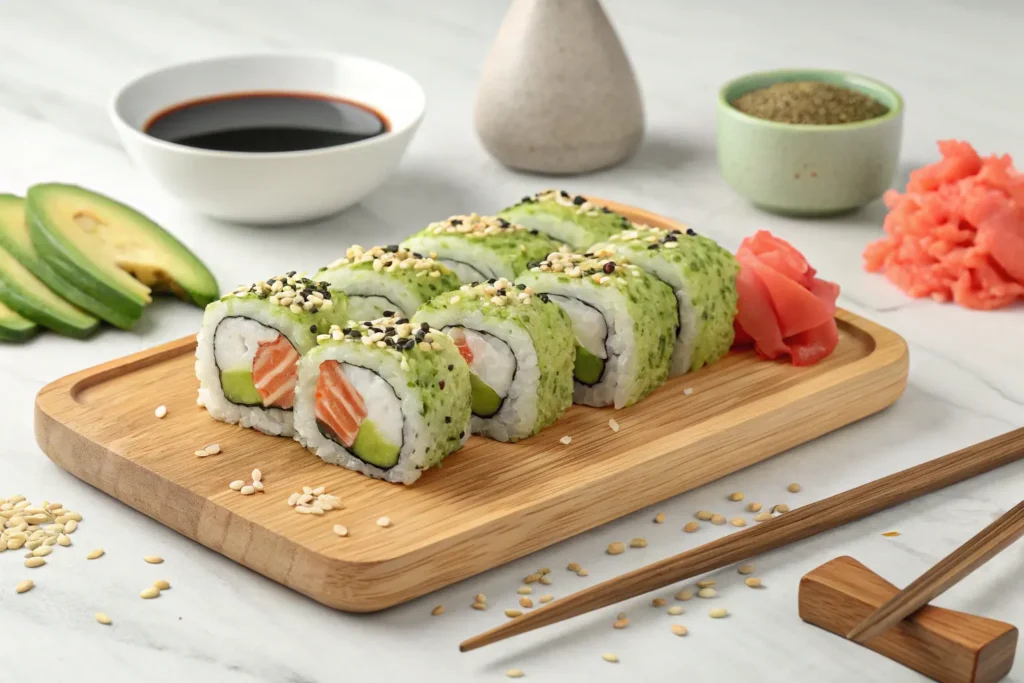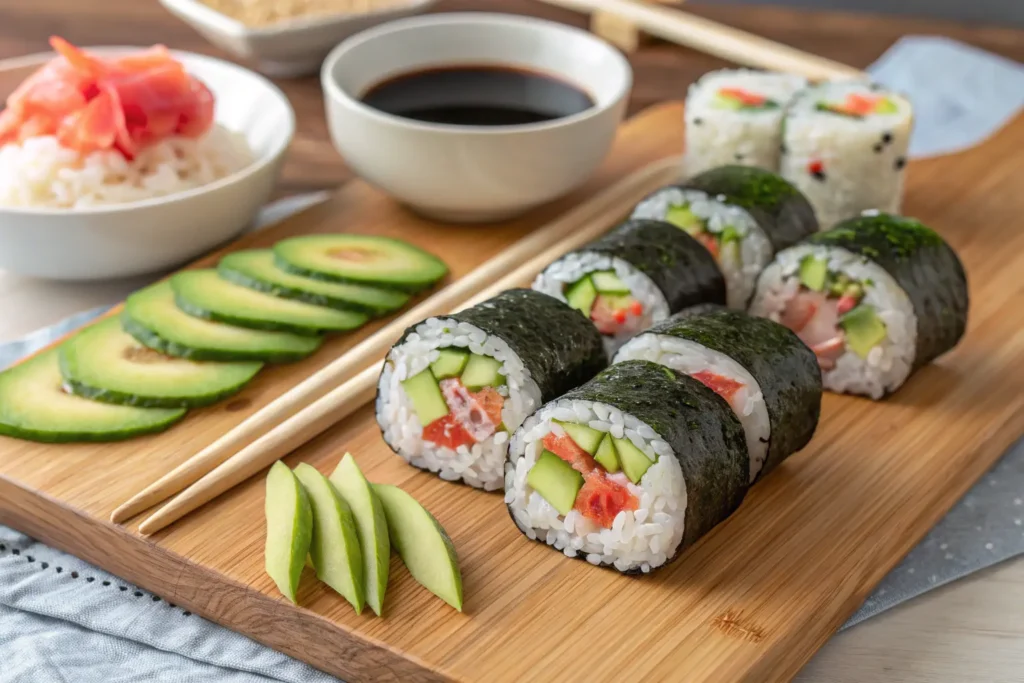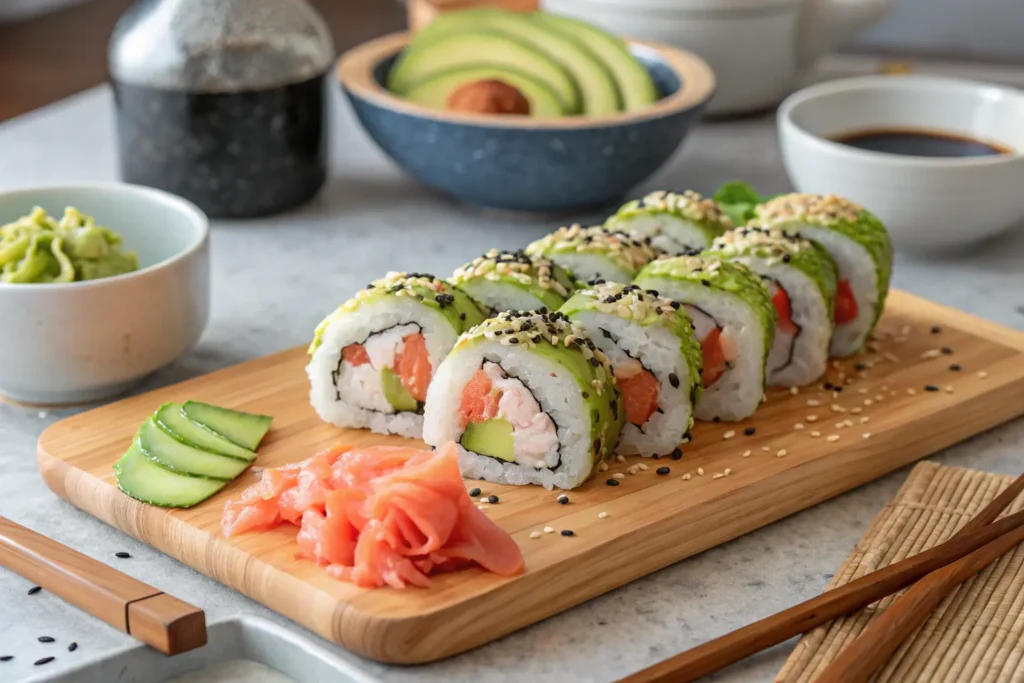Introduction: The Joy of Creating Sushi Rolls at Home
Remember savoring that first perfect bite of a sushi roll? The burst of fresh flavors dancing across your palate, the contrasting textures playing in harmony, and that stunning presentation that seemed beyond home kitchen capabilities? For years, I felt the same—admiring these culinary jewels while reluctantly handing over premium prices at restaurants.
Then came the revelation: crafting spectacular sushi rolls at home isn’t just achievable—it’s surprisingly straightforward. After countless takeout orders draining my wallet, I finally embraced the art of homemade sushi rolls. The journey transformed not just my dinner options but rekindled my kitchen passion altogether.
Today, I’m lifting the bamboo curtain on everything discovered along the way, empowering you to create sushi masterpieces that will genuinely impress even discerning food enthusiasts. Your days of paying exorbitant prices for this Japanese delicacy are officially numbered.
Table of contents

Why Making Sushi Rolls at Home is Worth It
The Hidden Benefits of Homemade Sushi
Looking beyond the obvious satisfaction of crafting something beautiful, homemade sushi rolls deliver remarkable advantages:
- Financial wisdom: Slash your sushi spending by up to 70% compared to restaurant prices
- Uncompromised freshness: Select premium ingredients personally for unmatched quality
- Custom creations: Tailor each roll perfectly to accommodate allergies or dietary preferences
- Memorable togetherness: Transform dinner prep into an interactive family experience
- Culinary growth: Develop a respected skill that improves with each rolling session
Common Myths About Making Sushi Rolls Debunked
Perhaps you’ve hesitated jumping into homemade sushi territory because of persistent misconceptions. Let’s clear those hurdles immediately:
“It demands professional training” – Not remotely true. Basic rolls require simple techniques anyone can master within minutes.
“Specialized equipment fills your kitchen” – A bamboo mat and sharp knife cover your essential requirements.
“Ingredients remain elusive” – Most supermarkets now stock sushi essentials, while online options deliver anything specialized right to your doorstep.
“The flavor falls short” – Using quality ingredients often produces results surpassing many commercial establishments.
Essential Ingredients for Perfect Homemade Sushi Rolls
The Foundation: Sushi Rice
Your journey toward magnificent sushi rolls begins with properly prepared rice. This foundation determines whether your creations soar or stumble:
| Ingredient | Quantity | Notes |
|---|---|---|
| Short-grain Japanese rice | 2 cups | Koshihikari variety offers ideal stickiness |
| Rice vinegar | 3 tablespoons | Unseasoned provides better flavor control |
| Sugar | 2 tablespoons | Balances the vinegar beautifully |
| Salt | 1 teaspoon | Fine sea salt dissolves most uniformly |
| Kombu (optional) | 1 small piece | Introduces subtle umami complexity |
Fresh Fillings: Mix and Match Options
The beauty of crafting sushi at home lies in endless filling combinations tailored exactly to your preferences:
| Category | Recommended Options | Preparation Notes |
|---|---|---|
| Seafood | Sashimi-grade tuna, salmon, cooked shrimp | Slice into quarter-inch strips against the grain |
| Vegetables | Cucumber, avocado, carrots | Julienne into matchsticks for even distribution |
| Creative additions | Cream cheese, mango, tempura asparagus | Balance textures between creamy and crunchy |
Mastering Sushi Rice: The Critical Foundation
The Perfect Cooking Method
Stellar sushi lives or dies by its rice preparation. Follow these steps meticulously:
- Rinse rice thoroughly until water runs nearly clear (typically 4-5 rinses)
- Allow rice to soak for 30 minutes before cooking (this ensures even hydration)
- Cook using precisely the right water ratio—typically 1:1.1 rice-to-water
- Rest covered for 10 minutes after cooking (this crucial step completes the cooking process)
Seasoning Your Sushi Rice
Properly seasoned rice delivers that distinctive sushi flavor and crucial stickiness:
- Combine vinegar, sugar, and salt in a small saucepan
- Warm gently until sugar dissolves completely (avoid boiling which alters flavor)
- Spread rice in a wide, non-metallic bowl while still warm
- Drizzle seasoning mixture while fanning the rice (traditionally with a paper fan)
- Fold gently using cutting motions rather than stirring to preserve grain integrity
Step-by-Step Sushi Roll Creation
Preparation Steps (15 minutes)
Begin with organization—your culinary workspace determines rolling success:
- Arrange all ingredients within comfortable reach
- Prepare fillings by cutting uniformly for balanced bites
- Place a small bowl of water nearby (for keeping hands damp)
- Position bamboo mat with slats running horizontally, covering with plastic wrap if desired
Basic Rolling Technique (Maki Rolls)
The fundamental rolling process follows these manageable steps:
- Place half-sheet of nori on bamboo mat, shiny side facing downward
- With dampened fingers, spread approximately 3/4 cup rice evenly over nori, leaving the top inch uncovered
- Create shallow indentation across center for fillings
- Arrange fillings in neat, horizontal line (less is more—overfilling causes structural problems)
- Grasp bottom edge of mat while supporting fillings with fingertips
- Roll forward with firm, even pressure, releasing mat as you progress
- Complete final seal using several grains of rice along the bare edge
- Allow roll to rest briefly before cutting for cleaner slices

Professional Cutting and Presentation Techniques
The Perfect Slice
Transform your roll into beautiful, presentation-ready pieces:
- Dip knife into water between each cut to prevent sticking
- Execute clean, decisive forward slices rather than sawing motions
- Halve the roll first, then align halves side-by-side for consistent sizing
- Wipe blade clean between cuts for pristine presentation
Artful Presentation Ideas
Elevate your homemade sushi from merely tasty to visually stunning:
- Arrange pieces in spiral patterns resembling blooming flowers
- Contrast colors strategically on dark plates for dramatic effect
- Incorporate edible flowers or microgreens for sophisticated garnishing
- Serve with small dishes of soy sauce, wasabi rosettes, and pickled ginger fans
Dipping Sauces and Accompaniments
Classic Accompaniments
The perfect dipping options enhance without overwhelming your creations:
| Accompaniment | Traditional Usage | Homemade Alternative |
|---|---|---|
| Soy Sauce | Light dipping (never soak) | Infuse with kombu and dried mushrooms for depth |
| Wasabi | Tiny amount mixed with soy | Prepare from powder or splurge on rare fresh wasabi |
| Pickled Ginger | Palate cleanser between varieties | Quick-pickle sliced ginger roots in rice vinegar |
Creative Sauce Recipes
Venture beyond tradition with these distinctive accompaniments:
- Spicy Mayo: Blend Japanese mayonnaise with sriracha and a touch of sesame oil
- Eel Sauce: Reduce soy sauce, mirin, sugar, and sake to glossy perfection
- Citrus Ponzu: Infuse soy sauce with fresh yuzu, lime, or Meyer lemon
- Avocado Cream: Purée ripe avocado with yogurt and lime juice for cooling contrast
Common Mistakes and How to Avoid Them
Troubleshooting Your Sushi Rolls
Even experienced sushi makers encounter these challenges—here’s how to overcome them:
- Problem: Rice sticks uncontrollably to fingers
- Solution: Keep hands moistened but not dripping; dip fingers in water with dissolved rice vinegar
- Problem: Rolls unravel when cutting
- Solution: Apply firmer pressure during final rolling; ensure proper rice distribution along sealing edge
- Problem: Filling spills from ends
- Solution: Place fillings slightly shorter than nori width; tuck ends gently while rolling
- Problem: Rice tastes bland or texture seems off
- Solution: Ensure proper vinegar mixture ratio; fan rice thoroughly during seasoning
Health Benefits of Homemade Sushi Rolls
Nutritional Advantages
Beyond delicious flavors, your homemade sushi delivers impressive health benefits:
- Omega-3 fatty acids from quality fish support heart and brain health
- Complex carbohydrates from properly prepared rice provide sustained energy
- Fresh vegetables deliver essential vitamins, minerals, and fiber
- Lower sodium content than commercial versions when you control ingredients
- Nori contributes valuable iodine and minerals often missing from modern diets
Adapting Sushi for Dietary Needs
Customize your creations to accommodate specific dietary requirements:
- Gluten-sensitive: Substitute tamari for traditional soy sauce
- Carb-conscious: Create riceless rolls wrapped in thin cucumber slices or soy wrappers
- Plant-based: Focus on tempura vegetables, marinated tofu, or mushrooms for meaty texture
- Pregnancy-compatible: Replace raw fish with cooked seafood options or smoked varieties
Storing and Serving Your Homemade Sushi Rolls
Freshness Guidelines
Maximize enjoyment with proper storage practices:
- Consume immediately for optimal texture and flavor
- If necessary, store up to 24 hours in airtight containers lined with slightly damp paper towels
- Keep refrigerated but consume at cool room temperature for enhanced flavor
- Avoid freezing completed rolls which dramatically compromises texture
Make-Ahead Components
Streamline preparation with these time-saving approaches:
- Prepare and refrigerate fillings up to 24 hours ahead
- Cook and season rice up to 6 hours before rolling (keep covered at room temperature)
- Pre-toast nori sheets and store in airtight container until needed
- Pre-mix sauce components separately, combining just before serving
Conclusion: Your Journey to Sushi Mastery
Creating restaurant-quality sushi rolls transcends mere cooking—it represents an accessible art form balancing tradition with personal expression. The techniques shared here lay groundwork for endless creativity, significant savings, and healthier meal options tailored precisely to your preferences.
Remember that mastery develops through practice—each roll represents an opportunity to refine techniques and explore new flavor combinations. Document successful creations in your culinary notebook while fearlessly experimenting with seasonal ingredients.
Transform your kitchen into a personal sushi bar where friends gather around your increasingly impressive creations. Beyond delicious meals, you’re cultivating a skill delivering satisfaction for years ahead. Your homemade sushi journey begins now—what flavor adventure will you roll first?
Ready to showcase your sushi creations? Share photos of your homemade rolls on social media with #HomeSushiMaster or comment below with your favorite filling combinations. I respond personally to questions and love seeing your culinary masterpieces!

FAQ About Homemade Sushi Rolls
Common Questions About Making Sushi Rolls at Home
Q: Is preparing sushi rolls with raw fish at home genuinely safe? A: Absolutely, provided you source sashimi-grade fish from reputable fishmongers or Japanese markets. These suppliers specifically handle fish for raw consumption, following strict freshness protocols. Always refrigerate properly and consume within 24 hours for optimal safety and flavor.
Q: How long do homemade sushi rolls remain enjoyable? A: For peak quality, enjoy your creations within several hours. While technically safe for consumption up to 48 hours when properly refrigerated, texture deteriorates significantly after the first day as rice hardens and nori softens.
Q: What’s the definitive solution for rolls that constantly fall apart? A: Three key factors determine structural integrity: properly seasoned rice (adequately sticky), appropriate filling quantity (less than you think), and confident, firm pressure during rolling. Most beginners improve dramatically after practicing just 3-5 rolls.
Q: Can authentic sushi rolls happen without specialized equipment? A: Certainly! While bamboo mats cost merely dollars and prove worthwhile, creative alternatives include silicone baking mats, kitchen towels wrapped in plastic, or even parchment paper for emergency situations. The technique matters more than the tool.
Q: What fundamentally distinguishes homemade sushi rolls from restaurant versions? A: Beyond significant cost savings, homemade rolls offer unparalleled freshness control, ingredient transparency, and personalization impossible in commercial settings. Many enthusiasts discover their homemade creations surpass restaurant quality through ingredient quality alone.
Have you given our recipe a try?
There are no reviews yet. Be the first one to write one.

